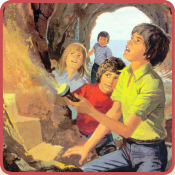
The Enid Blyton Nature Readers (No. 5)

Book Details...
First edition: 1945
Publisher: Macmillan
Illustrator: Eileen A. Soper
Category: The Enid Blyton Nature Readers
Genre: Nature
Type: Readers
Publisher: Macmillan
Illustrator: Eileen A. Soper
Category: The Enid Blyton Nature Readers
Genre: Nature
Type: Readers
On This Page...
- The Cross Little Tadpole
Story: Specially Written - Silky and the Snail
Story: Specially Written
Nature plates, illustrated by Eileen A. Soper


The Cross Little Tadpole:

The process involving spawn lying near the surface of a pond has been described countless times by the author but it has to be mentioned again in this particular tale because tadpoles are involved - and frogs of course.
Warm sun shines down to heat the jelly-like substance which contains many tiny black specks and most of us, especially those who have kept samples in an aquarium, will be familiar with the outcome. Nature always seems to give its progeny at least a chance in the survival stakes so the spawn, being too slippery for a predator to snap up, eventually releases the specks as minute wriggling tadpoles that swim to a clump of water weed where they fasten themselves and partake of their first meal.
They're now on their own and subject to another of nature's dictates - 'the fastest and strongest survive,' which means that natural forces are going to diminish the group. This shouldn't upset the balance too much however because according to a passing snail,
"The whole pond is full of them."
The dragonfly grubs are fond of a tadpole supper as are the water beetles but many survive despite the hostile entities surrounding them. Some have narrow escapes like the one that has a piece bitten off his tail; but that's simply classed as 'Luck of the Game.' Whether or not this particular tadpole will complete the full cycle is up to 'God's Grace.' Surprisingly, the tadpoles don't like frogs all that much because those creatures tend to chase them around, threatening to spank them if they're caught. That's typical Enid Blyton talk, as are the names yelled out when frogs are in the vicinity:
"Old croakers! Old greedy-mouths! Old stick-out eyes!"
One tadpole who considers that frogs are more than just a nuisance keeps hoping the ducks will arrive to devour them although, when he witnessed this once, they also gobbled up at least twenty of his brothers. Having heard from a stickleback that grass-snakes consume frogs, the tadpole swims off and calls to one that's lying on the bank. He tells him that a lot of nasty frogs reside in the pond and he'd be happy to show him exactly where they are. Having just eaten, the snake's not all that interested but the tadpole is assured he'll definitely come back in time to be shown the frogs' whereabouts.
The warm sunny days pass by ... and then it happens: Our little tadpole grows into a frog.
Oh Me, Oh My!
Silky and the Snail
Silky is a pixie who lives under the hawthorn hedge and one day a big snail happens to slide past her home. Silky has never seen one of these creatures before so, despite being a little afraid, she runs up and touches its hard shell. Commenting on the snail's ability to carry his accommodation around, she asks why he has a mobile home. The snail tells her that possessing a shell protects his soft body from birds and other creatures. He then demonstrates his ability to curl right up into it and when he emerges Silky asks him various questions as to where his eyes are, and his mouth, and then, when she enquires about his teeth the snail informs her that he has about fourteen thousand of them. Silky's very surprised to see they're located on his tongue! After the snail has shown her how he breathes, the pixie tells him she'll polish up his shell - and very soon the two become good friends with the snail often visiting Silky in the course of his travels.
One day Silky is sad. She wants to wear her necklace of blue beads to a party but the clasp is lost and she can't get anyone to mend it. The snail however knows of a chap called Mendy who'll be able to fix the necklace for her if he takes it along to him him this evening. Silky can collect it next day. This's all very well but the little pixie fears she'll get lost seeing she doesn't know the route to Mendy's house which is located in a wall some way off (fifth stone to the left and fifteenth up), but the snail tells her not to worry because he'll see that she finds her way all right.
Anyone who's read a few of the EB nature books will be able to figure out exactly how Silky manages to locate Mendy's place so that she can retrieve her necklace in time for the party.
Eileen Soper sometimes signed her pictures and the first one, which portrays a mass of frog spawn, has E, A, and S in small print at the bottom. The 'A' apparently stands for Alice.
A stickleback is a fish with spines next to its dorsal fin.
We've been informed many times by the author that tadpoles is short for 'tailed polls.' Not knowing how the word 'poll' comes into it, one of several definitions was found that indicates it as 'a person's head.' Fair enough.
#2: The name 'Silky' has been used before by Enid Blyton as a title for the prettiest of her characters - one whom Santa Claus (no less) wanted to place at the top of his personal Christmas tree, and now it's also been given to the pixie in this particular tale. The original Silky is identified with Enid Blyton's Faraway Tree novels. In 'The Enchanted Wood' (first of the series), Jo describes Silky as a 'fairy' although Enid Blyton (the Boss) calls her an 'elf.' In that excellent compendium Enid Blyton's Omnibus, she's referred to as a 'pixie' when Santa expresses his desire to retain her. I reckon 'elf' is about right.
Enid Blyton the educator has just revealed an intriguing fact that can be dropped into conversation with our friends - 'A snail has thousands of teeth!'
When the snail shows how he rolls down his feelers, Silky remarks that it's just like putting her hand inside a stocking, catching hold of the toe, and pulling it down to turn it inside out. An apt description.
For the record, Mendy's home is an actual hole in the wall.
Information: Eileen Soper's skill as an illustrator was almost certainly handed down from her father George who was a wonderful versatile illustrator, and whose illustrations hung at the Royal Academy nearly every year after his first exhibition at the age of 19. By the age of fourteen, four of her prints were hung in a gallery in Los Angeles. Two of these were later hung in the Royal Academy in London, which created intense interest and the comment from the jury " ... that Miss Soper, aged fifteen, can hold her own with giants." It was not until 1941 that her career as a book illustrator took off when the Macmillan publishers suggested her name to Enid Blyton firstly for a series of 'Nature Readers.' But it was the commission to illustrate 'Five on a Treasure Island,' presumably made at Blyton's insistence, that made Soper's name. (Book and Magazine Collector - 1995)








